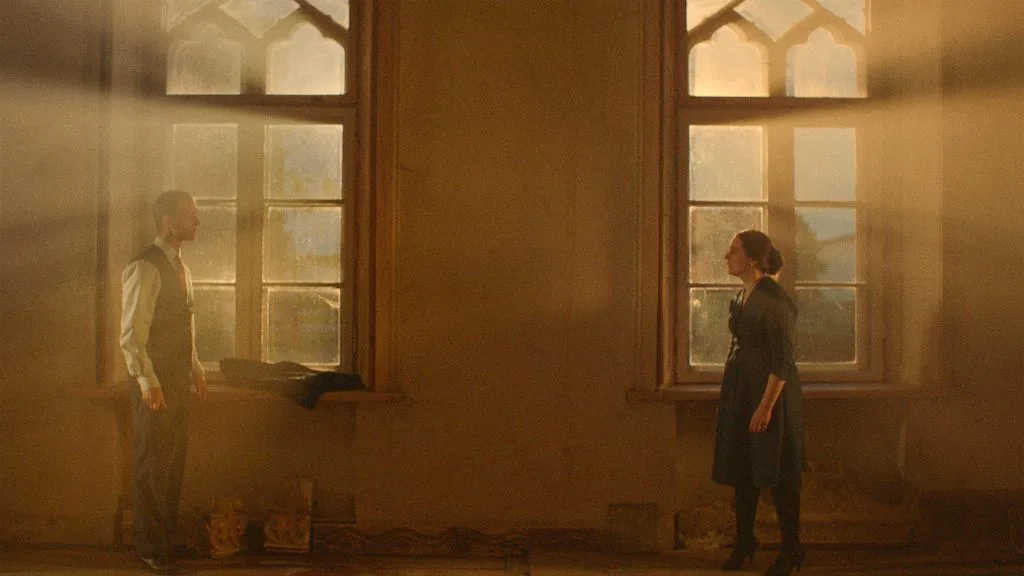
‘How long do you think we’ve been here?’ This early line in Dawn Breaks Behind the Eyes (2021) perhaps puts us in mind of a classic haunted house story: like The Haunting of Hill House, with its dreaming walls and watchful ghosts, the film is centred on a beautiful, if tumbledown castle, and the people who find themselves there. But the film has other ideas, and refuses to stick with one mode or trope. An avowedly experimental piece of work, it weaves familiar-feeling horror elements with something more meta; essentially, it’s asking what storytelling actually is, positioning filmmaking somewhere on its axis. It begins looking like something from a 60s Gothic pulp cover, segues into avant-garde Eurohorror and winds up dabbling with 60s counterculture. It’s a period piece, but not as we may know or recognise it. And it may attempt a little too much in its modest running time, but its strong aesthetics and genuine ambition prevent it from sinking into tedium, self-congratulation or insincerity. Here’s a film which would not only withstand a second watch, but seems to demand one.
We begin with Margot and Dieter, an unhappily-married couple taking the long drive to the same castle – which Margot (Luisa Taraz) has just inherited. This boon is seen as little more than a liability by Dieter (Frederik von Lüttichau), who envisions month upon month of renovations – which will need to be done so they can sell it, take the money, move on. When they arrive, he sets to, looking over every inch of the castle. Margot is a bit more considered, taking her time as she explores. When they each encounter something otherworldly in the castle, it seems attuned to their mental states; the uptight Dieter is terrified, Margot rather more entranced.
They stay the night. The next morning, the vision of the roseate dawn makes even Dieter see the place differently, but still very much with a view to sell; not so Margot, who now wants to stay. The more time she stays at the castle, the deeper her antipathy towards her husband, whose discovery of some mysterious items in the castle cellar does nothing whatsoever to level him out. But wait: if you were enjoying this tale, too bad. The story of Margot and Dieter gives way suddenly to a different story, and what appears to be a framing narrative: this new device also places Dawn Breaks Behind the Eyes in the category of metafilm, joining a fairly popular and established subgenre, particularly in horror: here, Berberian Sound Studio (2012) and to some degree, Censor (2021) come to mind, for reasons of mood, tone and visuals, to varying degrees. We are now – we might think – at the end of a shoot, watching the filmmaker and his team deliberate on the quality of their film, and the success of its ending. We’ll be invited to follow some of the same thought processes before the framing film also comes to an end. There’s something of a lull at this point – the pace drops, so that we can get to know these people – but look carefully, and there are a few key points and ideas which underpin the film – the one we’re watching – as a whole.
It would take some doing to make a location like this look dreadful; here, Herrenhaus Vogelsang (in Lalendorf, Germany) looks very beautiful, and the film-within-a-film also has a somewhat faded look which is consistent, embellishing the visuals selected and revealed to the audience. I could watch a candle burn in this film for ten minutes and still be charmed by it. Even the cracks in this marriage look gorgeous. The shift in the narrative is accompanied by a somewhat different visual and shooting style, though the castle itself retains its strange influence over people, eventually proving to be the real linking device. There’s arguably some homage, or at least some inspiration from the likes of Jean Rollin’s rustic-Gothic set pieces here, with a couple of dashes of 70s exploitation cinema, not least in the film’s queasy, peripheral treatment of sexuality, which is always thwarted, interrupted or otherwise made to feel unsettling, like it shouldn’t really be there. Eventually, it forms part of the circular structure of the film, keeping people together, keeping people apart.
Being such an experimental piece of work, particularly around narrative structure, means that this won’t be a film for every viewer, even though this film takes some of its cues from older films which themselves are not exactly neat, linear progressions (the same films many horror fans often rate amongst their favourites). But Dawn Breaks Behind the Eyes has ideas, it looks fantastic and it’s surprisingly economical, with some ambitious decision-making.
Dawn Breaks Behind the Eyes will receive a limited theatrical release on December 2nd 2022. It will be released on home media in February 2023.
